|
|
Post by kelly on Jul 10, 2009 10:07:00 GMT -6
Steve said, "If I get time, I'll start a blind set thread. Those thinking blind sets as fiction, can simply scroll on by."
I've enjoyed your previous posts and threads on this subject and would love to hear more from you if you have time. They are always appreciated by me and others here as well. Keep up the good work and THANKS for creating this site and allowing us to partake.
Thanks, Kelly
|
|
|
|
Post by bobwendt on Jul 10, 2009 11:08:36 GMT -6
I think if you saw wooded root wad stone type banks of southern indiana stone bottom creeks thru woods and pasture, rather than grassy even dredge ditch banks and swampy banks of the north country you would grasp blind setting. you guys that can`t fathom blind setting would understand if you saw our terrain here. without you see it, you can`t understand.
|
|
|
|
Post by blackhammer on Jul 10, 2009 11:23:33 GMT -6
Knew an old minker who every year on a small brook trout stream along a bunch of big rocks had a blind set.He always caught from 3 to 8 mink there.I thought it looked like a very average location.But the mink didn't think so.Every mink that went through there got caught in his blind set.Now I own the little piece of stream an like an idiot I set it up with a pocket down stream cause it's closer.I take a mink or 3 from this small crick.But I often wonder why I don't walk up stream,were the minker,my uncle set.Either there more mink in the years he trapped it or his blind set was better than my pocket.I had always thought on a small stream a good pocket would catch every mink that goes by.Going to try that blind set this year I think.Part of the reason I have not is it's a poor coon set.
|
|
|
|
Post by kelly on Jul 10, 2009 11:28:52 GMT -6
I understand blind sets for mink maybe more than most other residents of Iowa because of living/trapping elsewhere(Grew up in Wisconsin, lived in Colorado in the 1970's and Idaho from 1994-2006). All 3 of these states have many rocky streams where pockets are difficult to dig. My very first mink came from a blind set on such a rocky stream in North Central Wisconsin. All that said, am always wanting to learn more of how other trappers approach blind setting for mink and their techniques.
|
|
|
|
Post by jsevering on Jul 10, 2009 14:46:30 GMT -6
heres some rocky streams photos for you kelly    the second photo the sets just jump out at you, im not much of a typer but if you want to explain... have at it.... think your right and others that posted about a person should take advantage of what god and the stream itself presents them to take advantage of... be it blind, pocket or what ever is offered up.... be an awfully dull world otherwise....jim |
|
|
|
Post by garman on Jul 10, 2009 14:52:01 GMT -6
beautiful, streams bet ya cannot drive a stake LOL use alot of drags I am betting
|
|
|
|
Post by jsevering on Jul 10, 2009 18:46:53 GMT -6
thanks garman, there loaded up with brook trout..... wish they were loaded up with at least a few rats. use way more drags\clogs than i like thats for sure....jim
|
|
|
|
Post by trappnman on Jul 11, 2009 8:29:37 GMT -6
well, we will try it one more time- all the PMS I got encouraged me to do so and I thank you for your words.
first of all- a good trapper, one that knows his quarry, sets the location. If a weed filled high grass meadow, I make a hole set for coyotes- if dry hard baked bare ground, it begs for a flat set.
Same with mink. On many locations, flat land ditches and creeks that are usually managed, many times have intense vegetation coming down their banks- calls for baited pockets. I've set baited pockets ever since Christ was a pup and they are a heck of a good mink set. Its why I still use bait when I want to.
I've trapped big marshes- marshes that stretch for miles and miles-and in those blind sets and yes even pocket sets aren't worth a hoot.
And I've trapped as big a river as any of you ever have, and smaller rivers as well and pockets are the only way to go on such large habitat areas.
but thats not my locations HERE.
HERE- its small trout streams, winding down trough the hills, then turning into dead water on the flats before entering the Mississippi. Shallow with deeper pools here and there, but small- the widest is maytbe 20 feet, many are jumping across streams.
And at these locations, blind sets are the way to go for 1 simple reason- thats where the mink will be. And those locations jump out at you, and are as obvious to me, as the water running through the creek-
Nick mentioned something about catch mink in same location for years and years and thats 100% true. I have some rock formations, that I take multiple mink a year from year after year some going on 25 years. Other creeks, locations change on every stream changing flood- sometimes one almost gets tears in his eyes to see a favorite tree or log gone -but heres a tip-
if the shape of the bank hasn't changed TOO much- make a blind set exactly where that old location used to be- I find that for a year and many times 2, the location stays hot then becomes cold- but always, if I can, I'll reset those "lost" locations. Many times- another tip from someone that knows nothing about mink- I'll just take a #2 dls, push 2 sticks into bank, make a small depression over sticks and slide trap on- trap acts as shelf. All you need.
to blind set, or I should say to learn to blind set- you must take a couple of things as givens. #1: I believe that every traveling mink is a hunting mink (talking fur season here) and #2 creeks aren't run randomly.
If you consider these two things to be true, and I do, you then need to read the location, and its an easy task to put the trap where that mink wants to be-
if hes hunting, and hes at the creek, hes hunting that creek. hes going to be in certain areas on that creek, that hold the most concentration of food. the entire creek is not equal. And to get there, who knows where he goes? Thats why the statement about following mink tracks and set wherever they enter the water is such false information. If you have your heart set on setting on mink tracks wherever they hit the water, do so. I played that game, and reading tracks told me its a game you will never win. BUT what following mink tracks does show you, and I've followed miles and miles of mink tracks over the years and in fact take the time to follow some each year, is the concentration points.
WHERE on that creek he will be.
Before I forget, this thing about bridges. Bridges are more of a flat country feature. Hill creeks, the roads follow the creeks, and crossings are few and far between. I set up under 4 bridges, could if I wanted (although under bridges here is usually worst location- rip rapped or bare ground for 100 feet either side of creek) set more I guess- I do cross another 20 bridges or so- but many of them are river bridges, and that water is long froze up.
I cannot emphases enough, that location on a creek can mean difference between success and failure- one prime example is a creek I trapped for several years and never a mink or a rat- went downstream 150 yards and now its 4-6 mink location- consistently plus 10-15 rats-
mink travel overland for a reason- to get to where they are going- and if you know where they are going- if you know that 99% or whatever of the mink traveling that creek, will go to a particular spot- trapping them then becomes easy-
and understanding basic mink 101 tells you where to put the trap. For example, where is a mink going to go if hunting crayfish, fish, frogs, under water? hes not going to tread water and eat, he's going to find- as one self appointed guru states- a resting spot to consume that meal. If ones not where you want it, make one- lay a log against the bank or even overhanging the bank, make a depression, and you will catch ink. Or so I've heard.
and if a stretch of creek is between two good, close by locations, then chances are that stretch will be the main highway. Deep water, put in whatever you like- baited or unbaited pockets- I find that an unbaited pocket, works on mink as well as a baited pocket. Esp if you have water going back into it.
so another tip- while its a joke that mink investigate every hole, they do investigate holes where they expect to have a possibility of food. Frogs, fish, etc often erst in these shallow water quiet areas on natural pockets- so do the same. I often cut it so water is 4-5 inches deep in back of a blind, unbaited pocket. On sheer banks, don't worry about ledge for trap, just do the sticks and #2 trick.
If shallow water, a rock tunnel made with softball sized rocks, maybe 3-4 feet long and just wide enough apart to hold a trap, will have every mink traveling that stretch, going right down the middle of them.
bottom line, know why hes there, and set where he would then be(based on why). Its that simple, and that complicated.
As far as trap nights, the most worthless statistic of them all. Location success is the only statistic that matters to me.
|
|
|
|
Post by Gerald Schmitt on Jul 11, 2009 9:23:48 GMT -6
Hey Steve, good post, you have a good start for a book. It bears mentioning that SE Minnesota where you are at is night and day different from SW Minnesota when looking at terrain. Lots of our drainage is man made due to the flat prairie.
|
|
|
|
Post by trappnman on Jul 11, 2009 9:41:39 GMT -6
thank you Gerald.
|
|
|
|
Post by trappnman on Jul 12, 2009 10:08:34 GMT -6
hard to take blind set pics, cause in most cases so subtle- but here a little blind pocket, about the size of my arm that went 10-12 back, water in bottom- took 3-4 mink here before this coon. 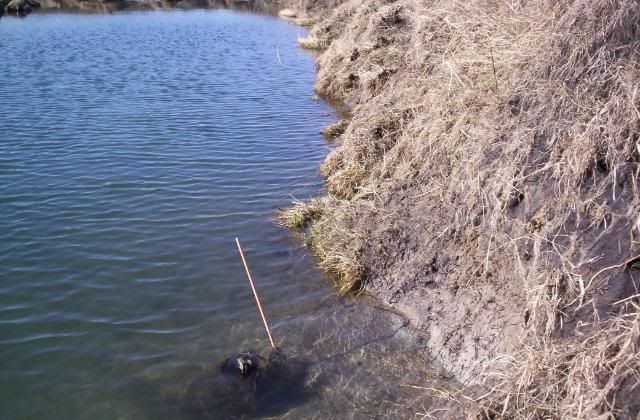 ----------------- sheer bank like this calls for baited pockets- you can see one at left of pic- its how I make my combo mink/coon pockets 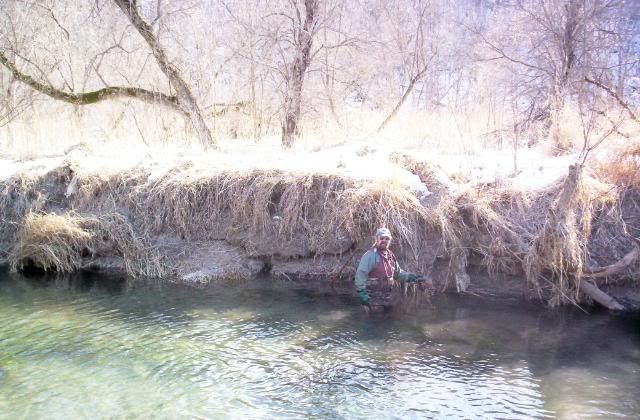 ------------------ natural unbaited pcoket in rip rap- consistent for mink and coon  ----------------- Similar unbaited pocket- 3 there this year I think- 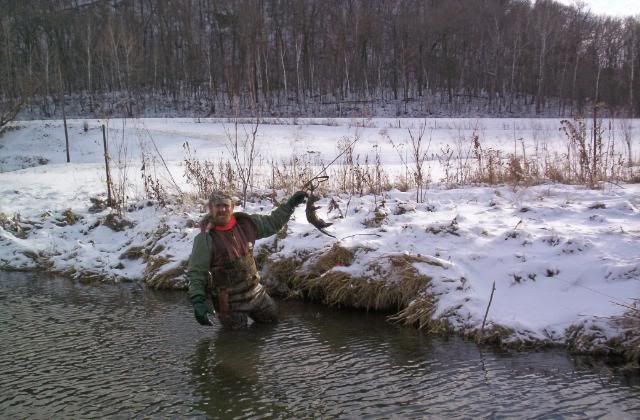 ---------------- the undercut bank before a rapids at a deep hole? textbook  ------------------- As simple a blind set as you can get- cut out a notch under the shelf- little pool here 4-5" deep where aveage is 1-2  ---------------------- A classic location- this spot gives me 3-5 mink year after year for almost 25 years.  ---------------------- BK would put bottom edge set here, I put foothold in cutout- one of my best sets last season- You'd dig no pockets here- pure sand on high bank, pure rock on low bank  ------------------- Owl got somehing between these unbaited pockets - hope it wasn't a mink- 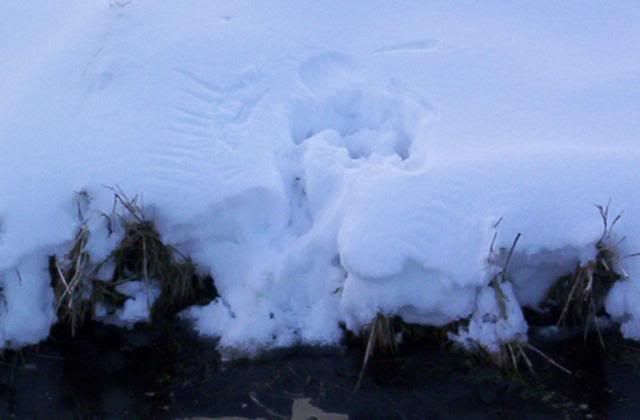 ---------------- typical, typical, typical- choose the deepest, etc- 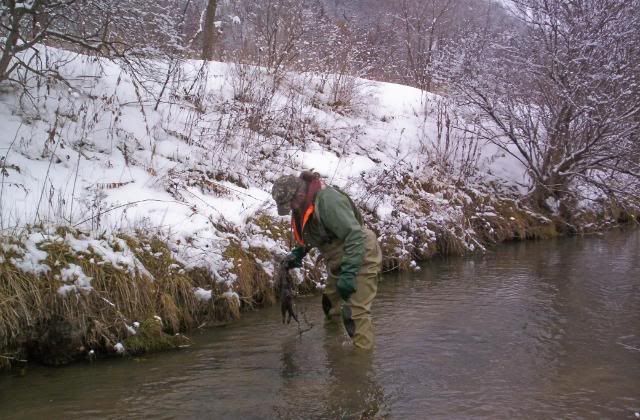 --------------------- taking a mink out, the set, the closeup  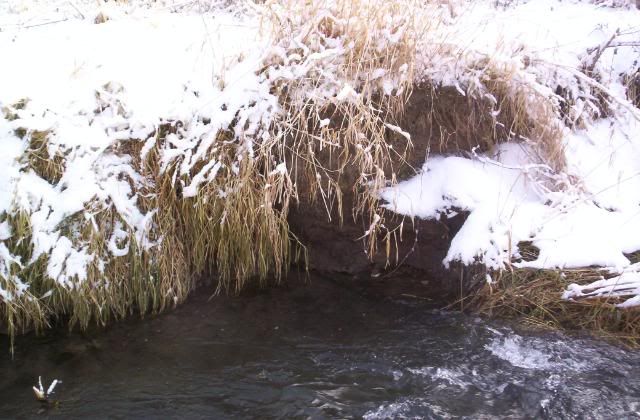 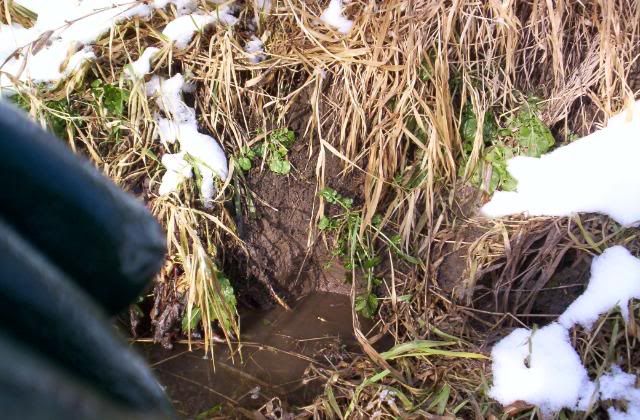 ------------------- cutout under log after snow, then after a mink 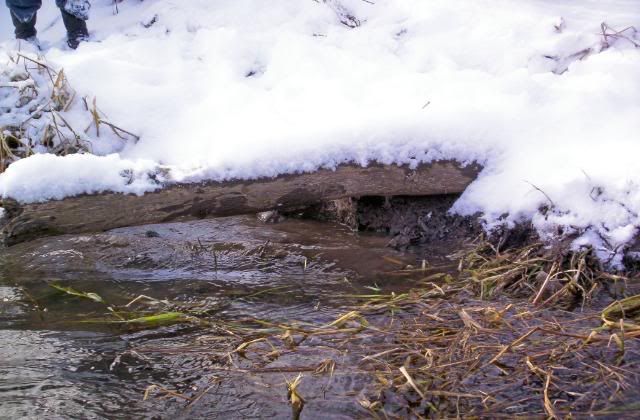 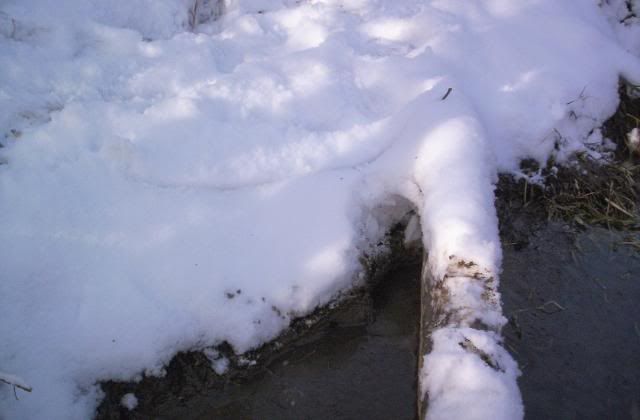 --------------------- a blind set w/visuals? yup 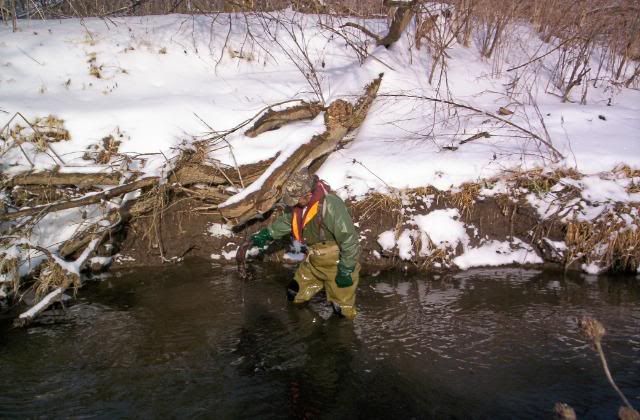 -------------- A big Mn mink............ 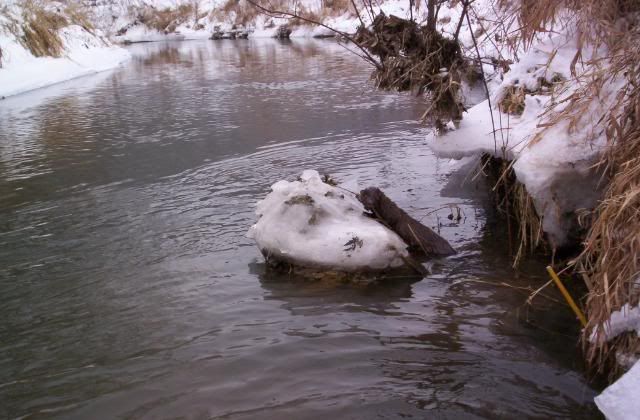 |
|
|
|
Post by makete on Jul 13, 2009 15:07:03 GMT -6
In jsevering's first photo, would you set on the top ledge above the roots or would you set under the roots?
|
|
|
|
Post by makete on Jul 13, 2009 15:20:13 GMT -6
If shallow water, a rock tunnel made with softball sized rocks, maybe 3-4 feet long and just wide enough apart to hold a trap, will have every mink traveling that stretch, going right down the middle of them.
.........Do you mean that if you make a tunnel of stone 3 to 4 ft long that mink will investigate? How many traps? One at both ends?
|
|
|
|
Post by bobwendt on Jul 13, 2009 15:31:29 GMT -6
you guys think mink. nothing I like more than blind setting a shaky coyote. my ( one of at least) best is after I had taken about 20 at a hog dump. one cam,e every night and fed and ignored everything. one morning I loked and saw he climbed up on the sawdust pile ( frost) before feeding, or just to ck. everything out maybe. I buried a trap on the toppety top. had him next morning. no more coyotes. he was it. or intentionly making a dummy set down a trail of MY CHOOSING. then blind set the trail 20 feet away from the dummy set. I make them blind but prefer I choose the blind if he won`t talk.
|
|
|
|
Post by jsevering on Jul 13, 2009 18:00:03 GMT -6
on that first picture with the roots, you can do both, i chose the water on both sides one where the pull out was outside of the picture to the left, on the other side of the yellow birch and one where they were dropping back down into the brook through that first hole to run under root system and boulder or bounce back up through the roots before the boulder to work the back of it... only keep traps in the water to hopefully drown them.... but imagine a man could set up a 110 dry behind the part of the root system where the yellow birch root sucker took of for the sky fairly easy or behind the boulder if he had a mind to....jim
|
|
|
|
Post by trappnman on Jul 13, 2009 19:37:04 GMT -6
my first instinct would be to set under double log on left-
yes, open tunnel with no roof. Rocks sticking 2-4 inches out of water- we always did ttap at bottom end but I've often thought of setting both- reason I don't is I think he'd get hung up in the rocks and not drown- bottom traps usually puts him in current
|
|
|
|
Post by mustelameister on Jul 13, 2009 20:44:57 GMT -6
Steve, I really like this picture--  Looks like good southern exposure, warm banks that will shed snow readily, easy to work with, yet won't cave in. But . . . why not two sets? Or three? Not knowing the situation at all but from what I see in the pic, I'd like to believe I'd have for sure a set about six feet behind you in that big divet that sort of looks like the one you've got the pocket in. Then maybe one inbetween, right there where you can't see the bank 'cause you're blocking the view. Three sets. All hooked up to drowners. Maybe a baited pocket in the middle with the two blind sets on either side. Or all three blind. What say ye? |
|
|
|
Post by rk660 on Jul 13, 2009 20:57:21 GMT -6
I guess looking at the photos, I could see just carving a perpindicular bank where one wants to blind set, decided by where I thought most activity would be. Simple jump stick and outside jaw gaurd stick, or a pocket set, guess i dont see where one or the other would really outshine the other.
|
|
|
|
Post by trappnman on Jul 14, 2009 7:41:45 GMT -6
that about sums it up rk-
MM- there are 7 sets at this location. Where I am standing, is about the deepest point at this point- solid rock bottom as well.
Behind me, maybe 30 feet, is a deep carved bowl with those clay banks. I have two baited pockets there on slides. About 15 feet in frony of me, huge impassible log jam, so I get out here, go around, then have 2 blind sets one on each side below the jam. THis pool is maybe 20" around, then goes into a small (2-3") channell w/a bend, have a slicked up unbaited pocket here o na drag.
This total location gives me 12-15 coon, and 6 or so mink, plus 6-20 rats depending on year.
Same sets within inches year after year.
Fairly stable as far as ice, wish all locations this productive and easy to work with.
|
|
|
|
Post by Gibb on Jul 14, 2009 9:58:00 GMT -6
Steve, do you use many 110 or 120 size traps for blind setting mink?
Jim
|
|